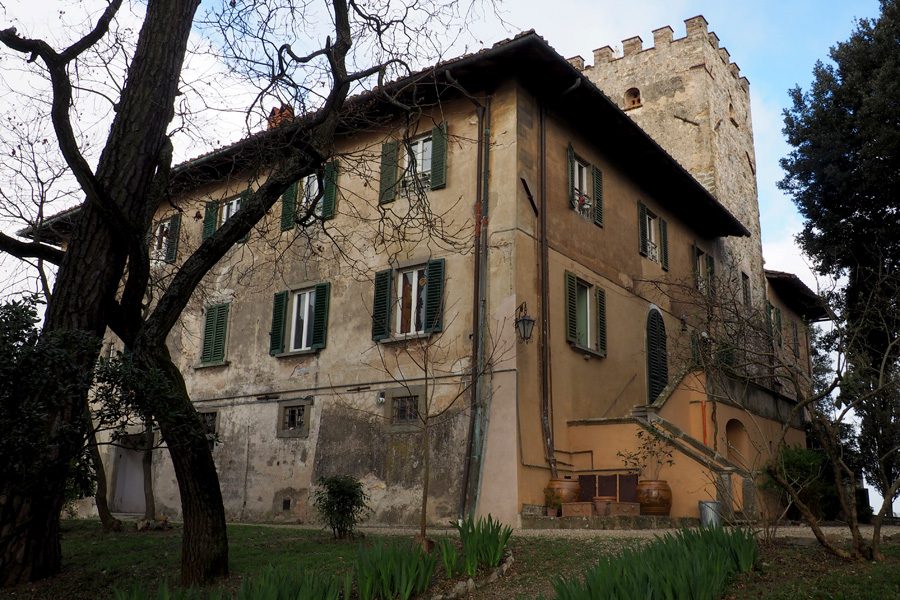
Our Tuscan Home in San Donato in Colina
I have been dreaming of driving around the Tuscan countryside visiting small towns along the way since 2005 when two men that I admire purchased a house there. I imagined small markets, narrow roads, vineyards, hills and elderly Italians. Over the past six days, my dream came true.
Last Thursday morning, Nik and I rented a manual transmission Fiat Punto. He took the driver’s seat, and I was his navigator. We made our way out of town to the scenic route through the Garfagnana Valley that runs between the Apennines mountains to the north-east and the Alpi Apuane to the west. The forests were not lush with fresh spring leaves quite yet, but driving through the valley and up and down the foot hills was amazing. We also had a great meal at a random Trattoria on the side of the 2 lane backroad we were on.
As we neared Lucca, we made our way to the Auto Strada to take us the rest of the way to Florence. We had both read about how to navigate the ticket & toll booths, so we knew NOT to go through the Telepass lane and that we HAD to get a ticket when we entered. Otherwise, we would be fined and it would be a nightmare.
Once in Florence, we exited the Auto Strada and paid our 5,50€ toll and switched from Google Maps to the detailed driving directions that were sent by the couple we were renting an apartment from. When we found our home in Tuscany, it was everything we hoped it would be. We settled in before walking through the little town of San Donato in Colina to buy supplies for dinner and breakfast the following day. Then we sat back to enjoy the sunset and a quiet evening.
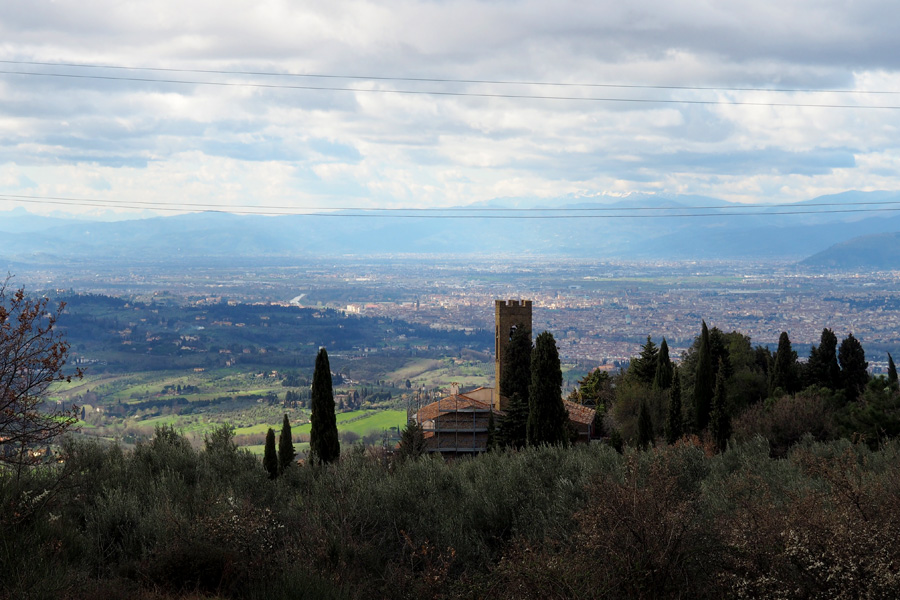
Our view with Florence in the distance
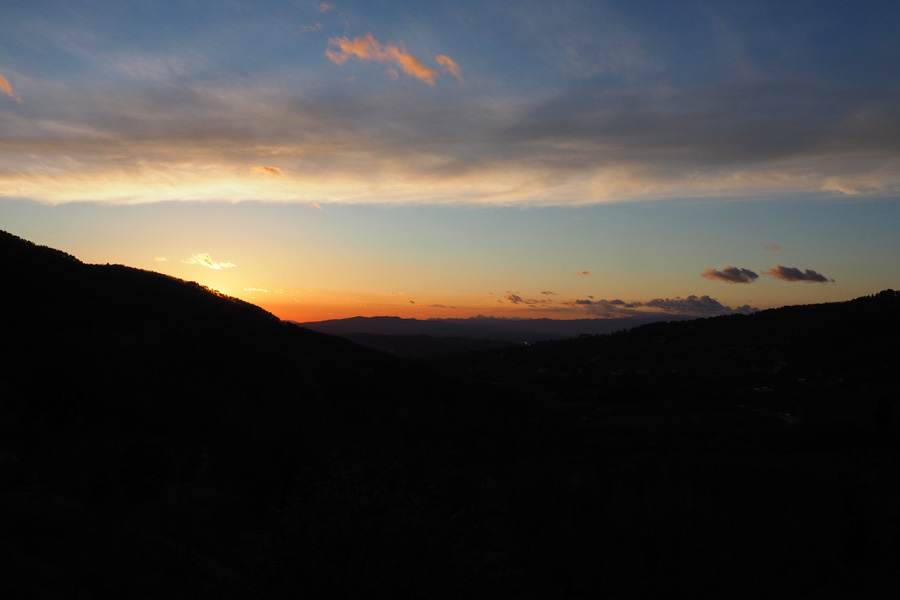
Sunset over the valley from our Castle
It rained on our second day, so we went on a bigger grocery run and did laundry. In the afternoon, we strolled up to the monastery near by for an even better view of Florence, and then spent the evening planning and researching for Sicily and Turkey.
On the third day, we drove scenic State Route 222 south to Siena. Nik honed his Italian driving skills, and I took the wheel for a little while as well. My goodness, that was exhilarating!!! It was the first time I have ever driven a car in a foreign country (other than Canada), and what a great place for my first time.
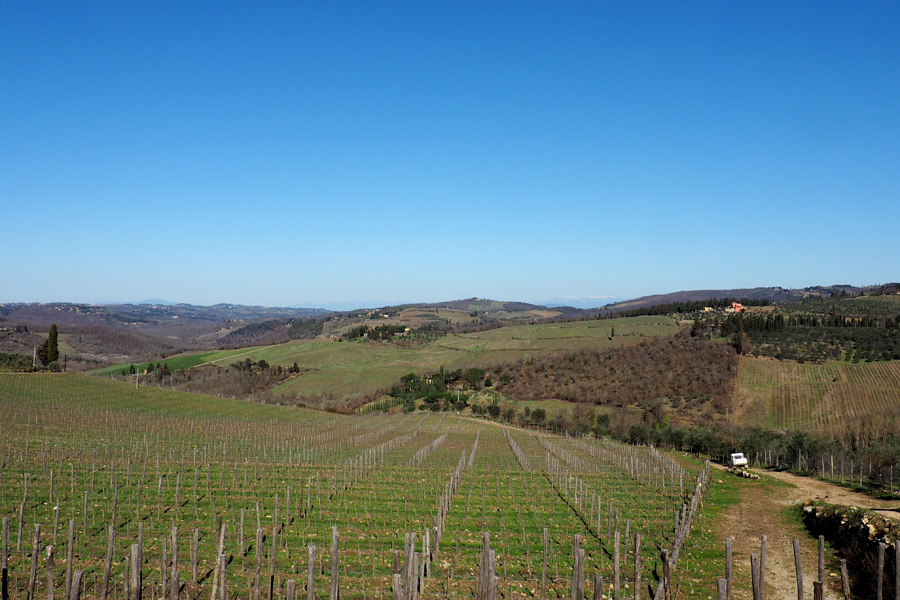
Tuscan vineyards in spring
Siena, as expected, was stunning. The main tourist streets were busy with school groups, but the side streets were nearly empty. We happened to find a local wine and food showcase in the Mercato where samples of cheeses, dried meats, breads, and panforte were plentiful. Nik took a liking to the panforte so we tried to purchase a small wheel from one of the vendors, but apparently they weren’t selling it. We thought it was odd, so we carried on and found it in one of the tourist shops on the main square later that day.
The cathedral in Siena was the first we have seen with black and white marble laid in alternating stripes on the facade and interior. I remember seeing photos of this in architectural history class, but seeing it in person was much more memorable. Also, the floors of the Siena Duomo have carved marble depictions of biblical scenes using red, white and black marble.
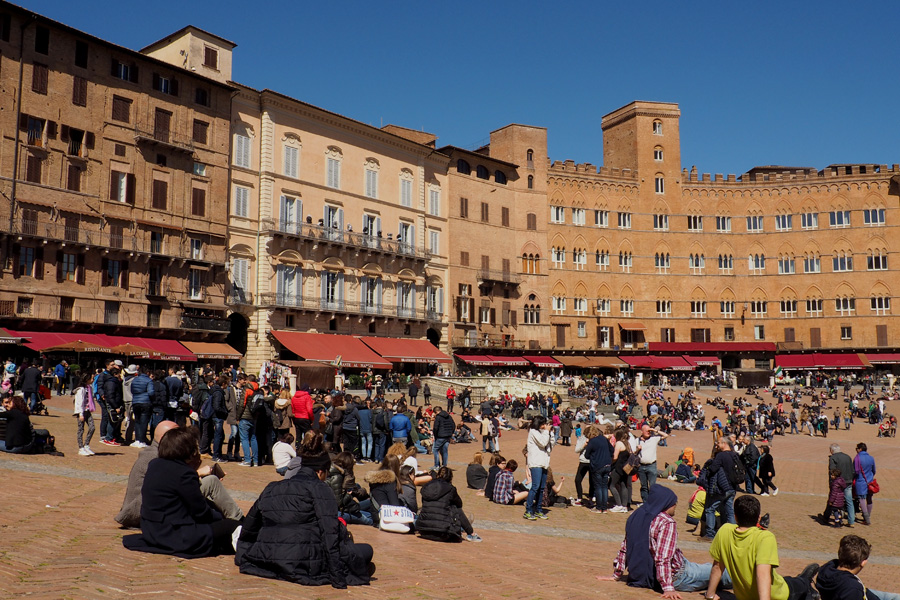
Piazza del Campo
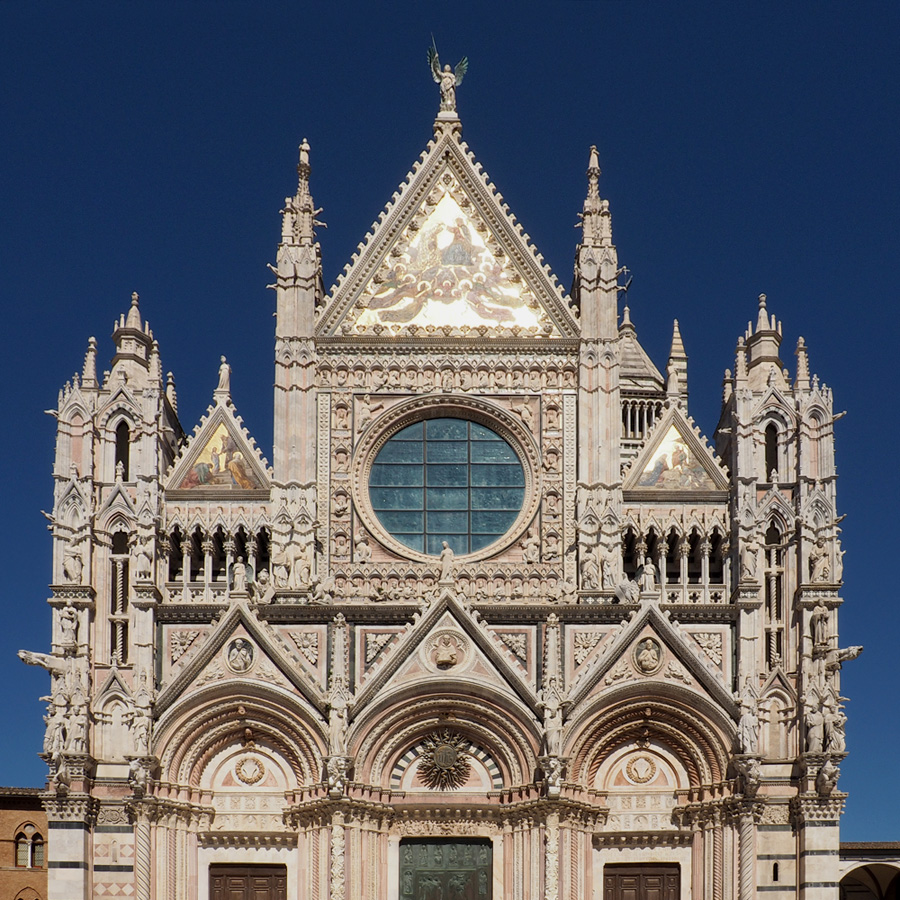
Siena Cathedral
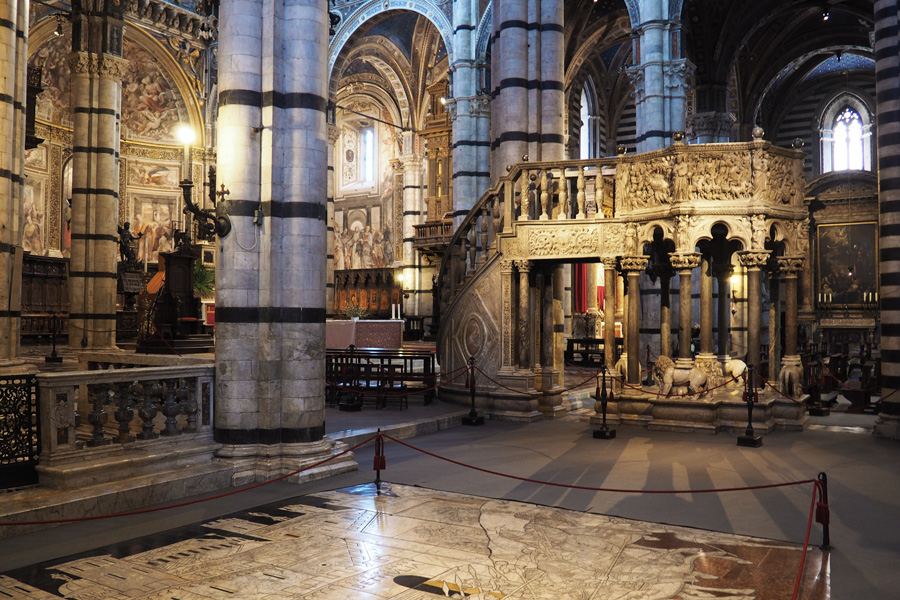
The pulpit and carved stone floors of the Siena Cathedral
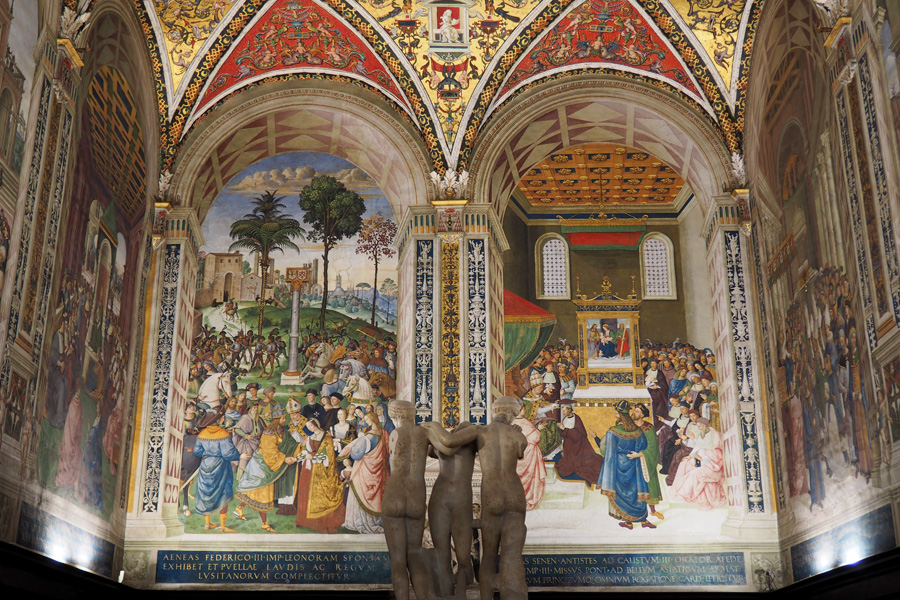
Piccolomini Library in the Siena Cathedral
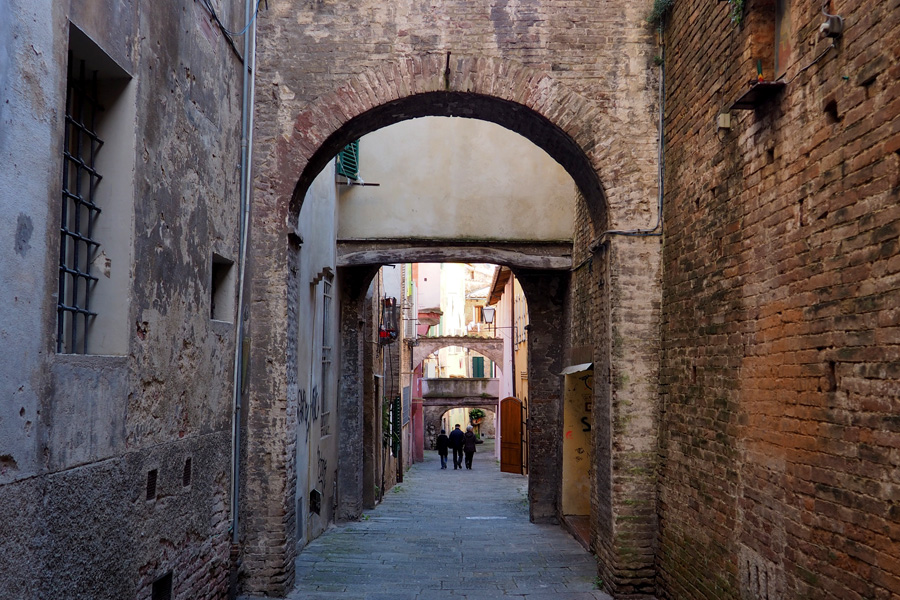
Streets of Siena

Doors, doors, doors
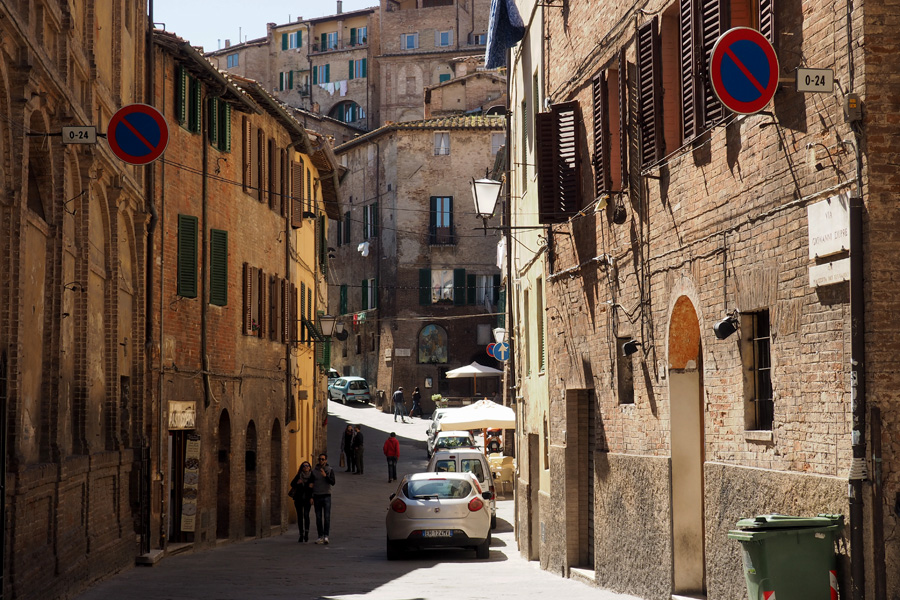
More streets of Siena
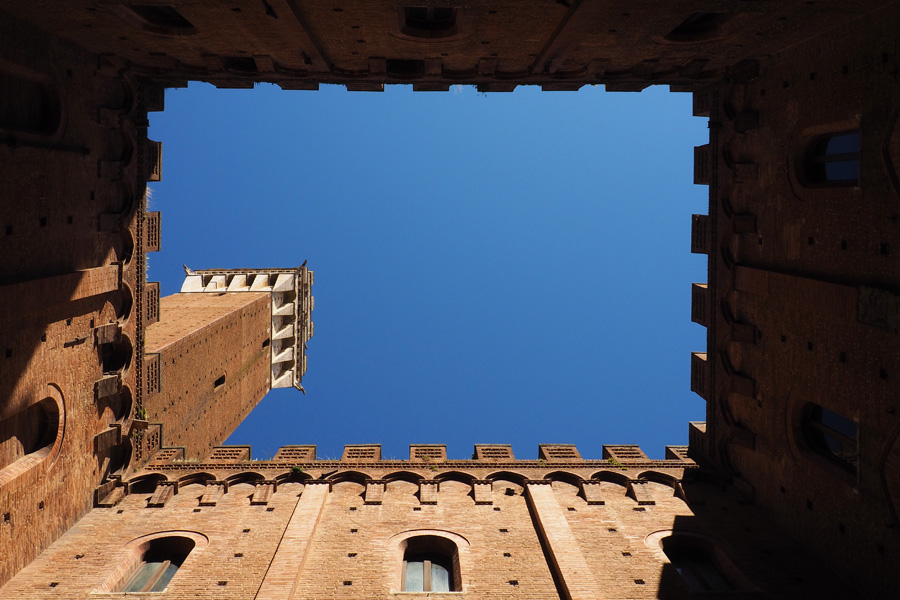
Courtyard
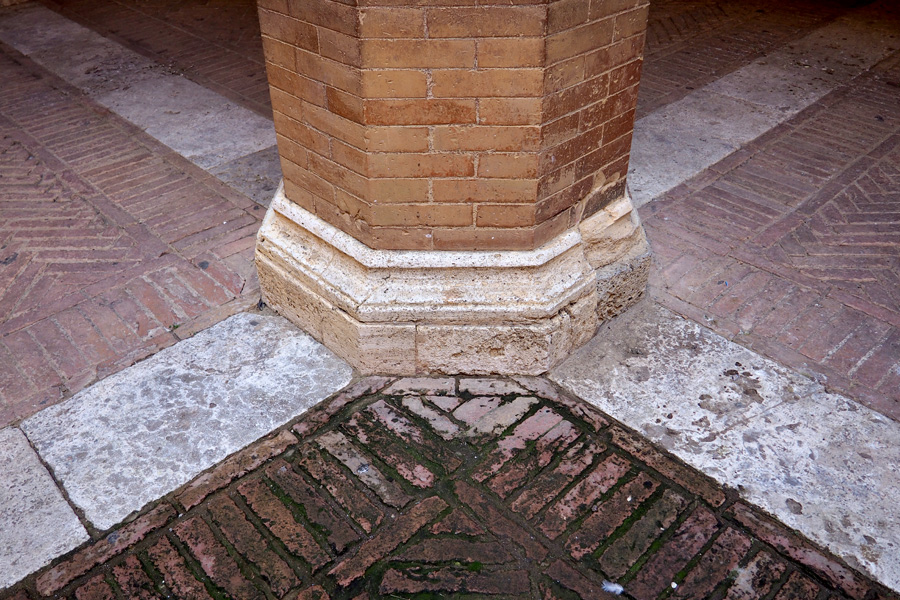
Brickwork
On the drive back, we went through the Chianti region taking a few detours to see what we could see.
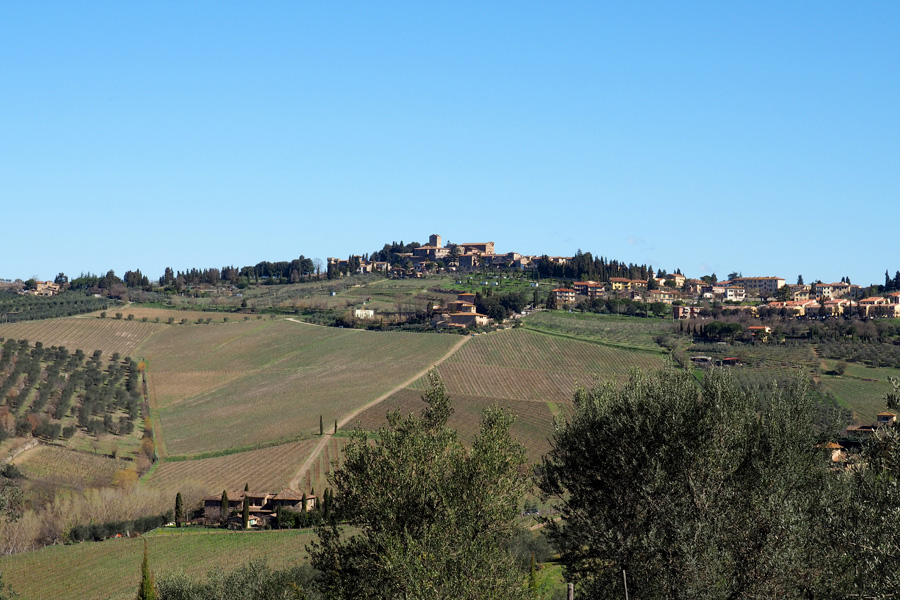
Bucolic landscapes
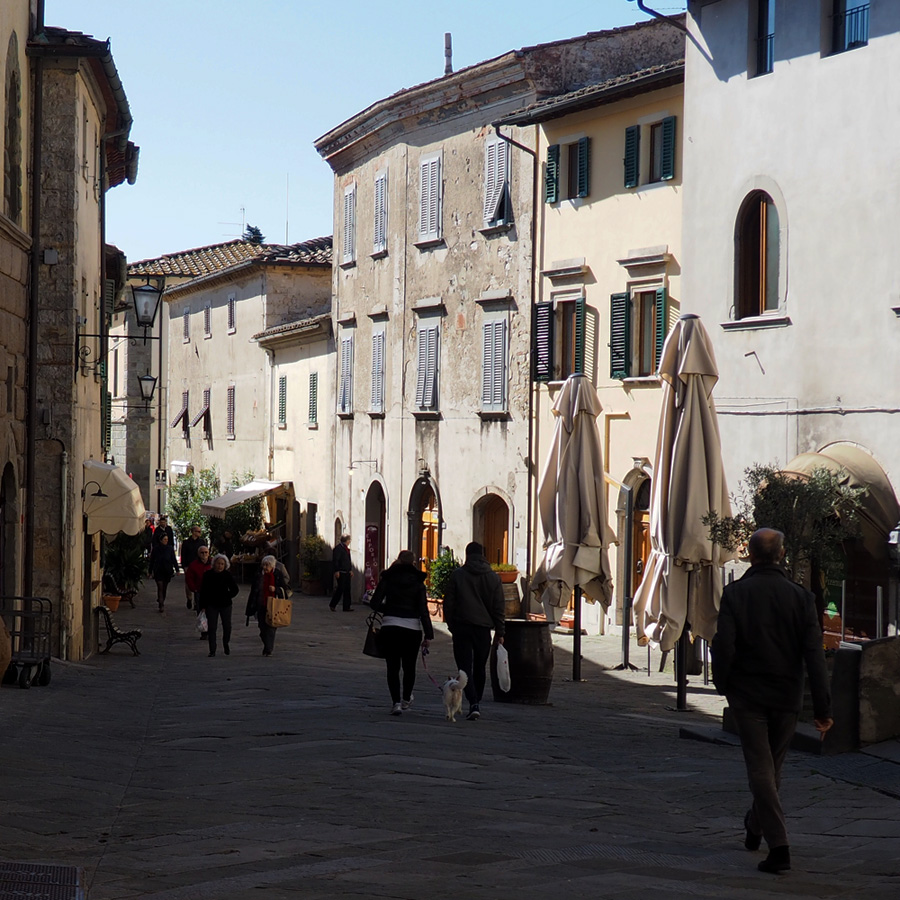
Small hill town street

Hills
On the fourth day, Sunday, we drove to Florence and spent the day walking through the main streets and side streets trying to avoid the tourist masses as much as possible. We also searched for restaurants unsuccessfully for at least 2 hours which led to a couple of cranky Americans with cameras.
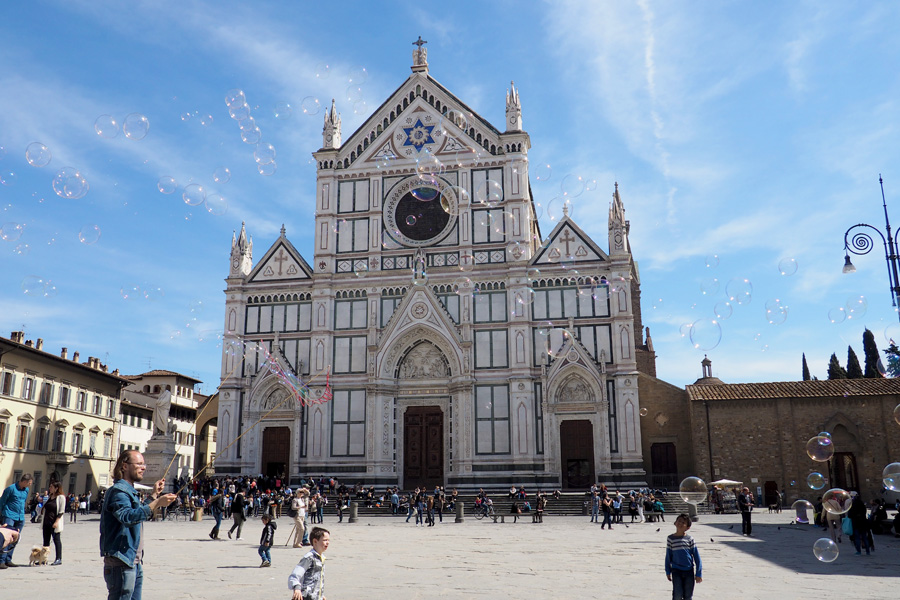
Basilica of Santa Croce (Chapel of the Holy Cross) in Florence with Bubbles
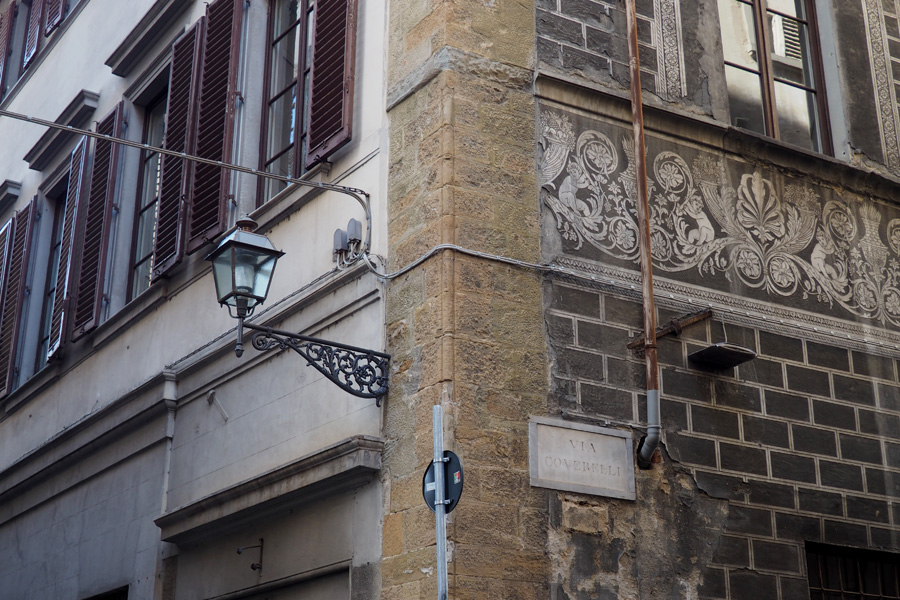
Every corner has details
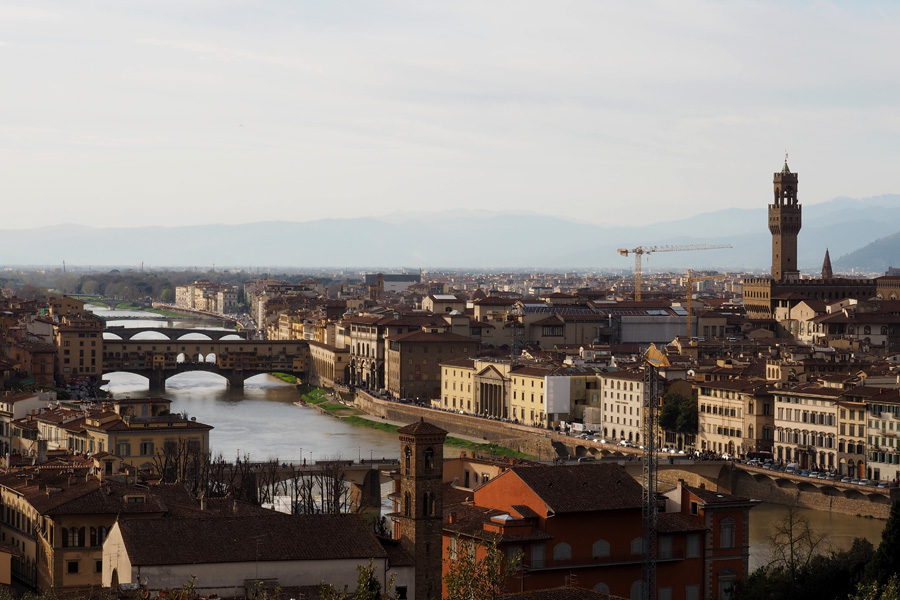
The Arno River
On our fifth day, we slept in and took a drive. The goal of the drive was to have dinner at a restaurant on the north side of Florence, but instead of heading north, we entered the Auto Strada heading south and couldn’t get off for another 20 kilometers. At that point, we abandoned the plan for dinner and meandered through the countryside and along the river and back home.
For our sixth and final full day in Tuscany, we drove south again to see the hill town of towers, San Gimignano. We took the highway there and then took our time winding through backroads on the way back. The city is the ultimate small, Tuscan hill town. The historic city center is a smaller version of Siena with architecture that is even more consistent and clean swept. After making a loop through town, we stopped for lunch at a garden cafe owned and run by a sweet young Italian couple. Then we climbed to the top of the tallest tower in town for a panoramic view of the surrounding countryside and celebrated our accomplishment with gelato.
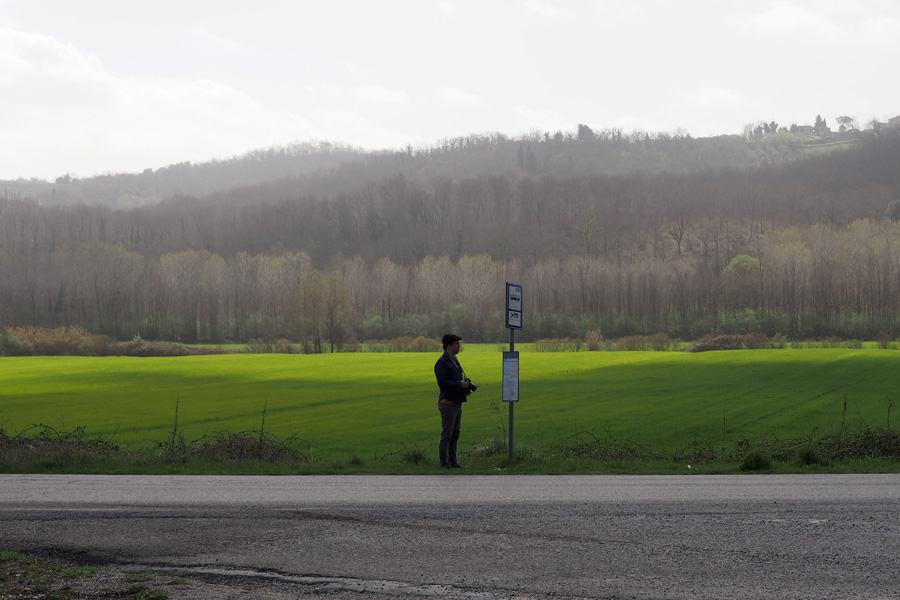
Nik at the bus stop
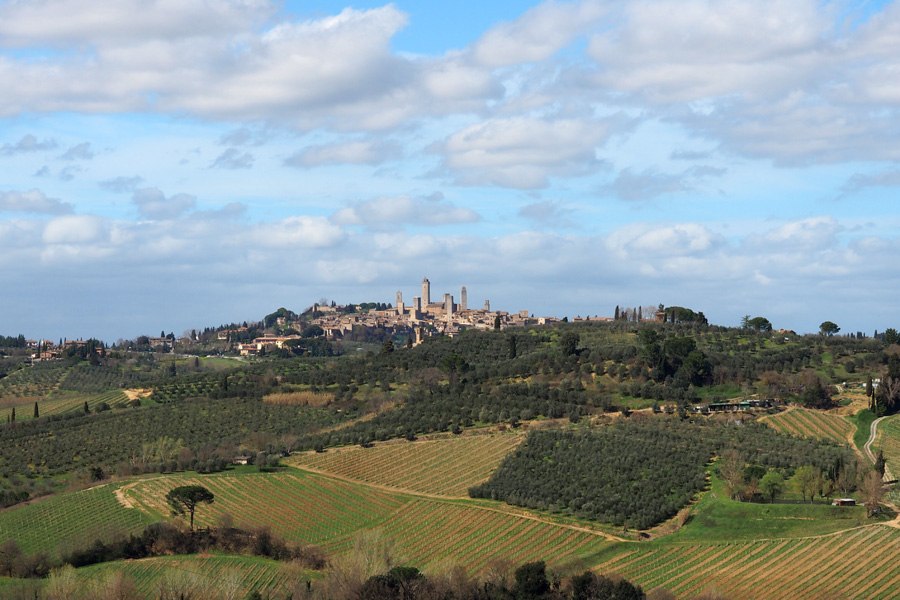
San Gimignano – A town with towers dating from the 13th-14th centuries
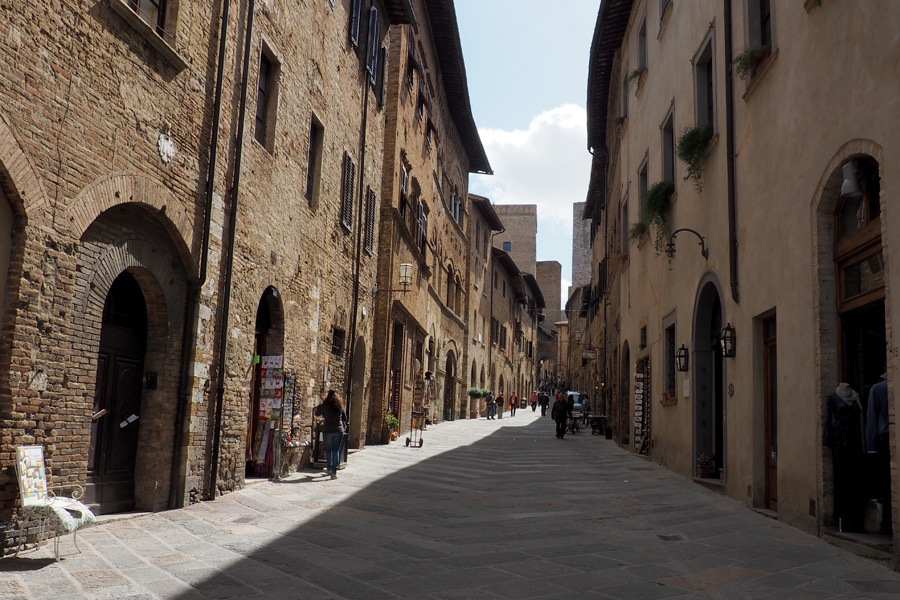
The streets of San Gimignano
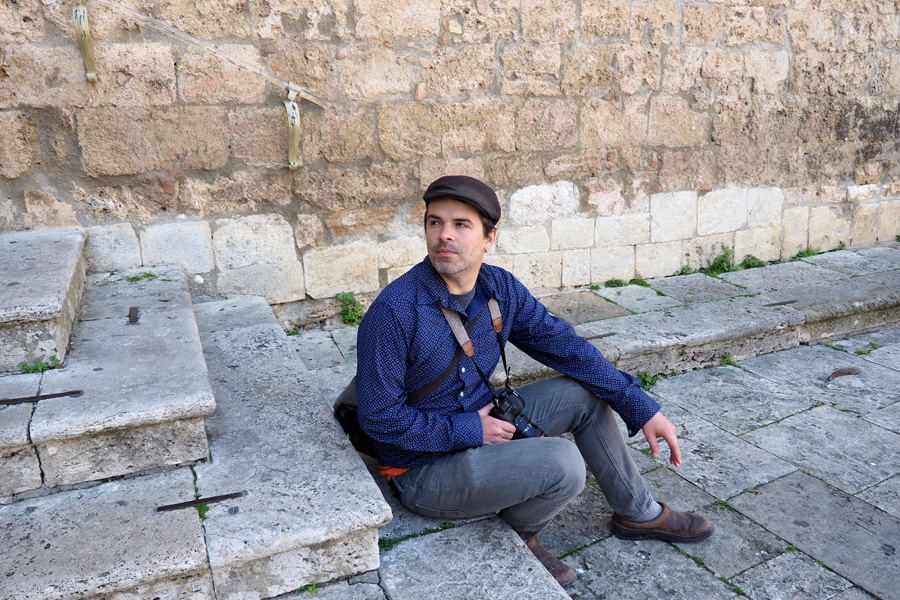
Handsome
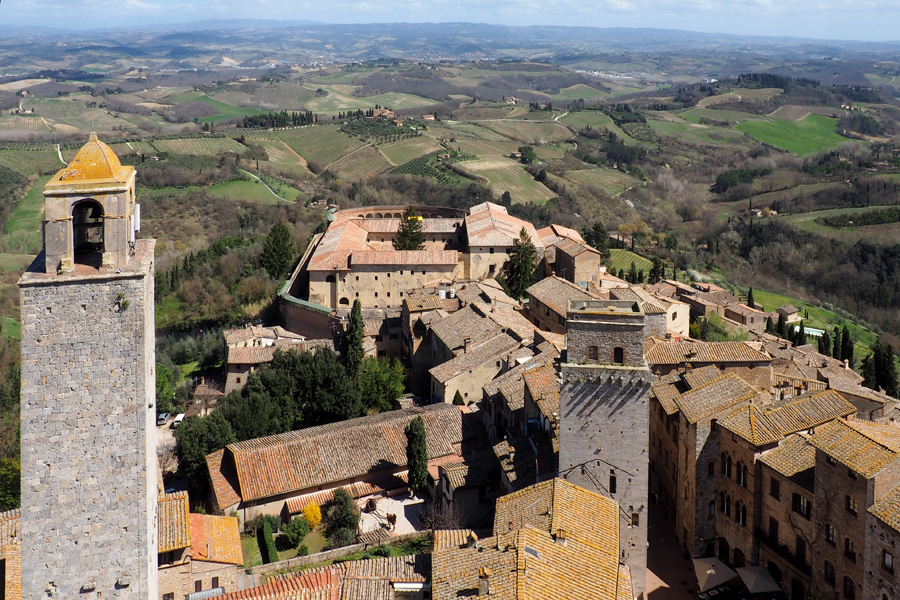
View from the Palazzo Comunale tower in San Gimignano
When we got back to our apartment, Nik took a nap while I watched a Harry Potter movie.
On our final day, we packed up and left our Tuscan home around 9:30am for one last super drive on the Auto Strada to Venice. Our week was perfect, and I would do it again in a heartbeat. I think we had an easier time on the roads and in Siena, Florence and San Gimignano because it is not tourist season yet. I honestly cannot imagine keeping Nik happy in Tuscany if there were more people everywhere…I’m glad I didn’t have to!
Nik’s Post: Ah, Not Summer in Tuscany

Our view from Manuel’s Guesthouse in Monterosso
On Sunday morning at 9:57am, Nik and I took our 2nd Class seats in a compartment of 6 and rode for 3 hours from Termini Station in Rome to La Spezia Centrale. Then we transferred to a local train for the final 15 minutes of our journey to Monterosso Al Mare (Red Mountain of the Sea), which is the northern most town within the Parco Nazionale delle Cinque Terre. The train rides were uneventful in a depressing way, I was tired from another restless night combatting an allergic reaction to laundry detergent, it was 2 hours past lunchtime, I was carrying 4 months worth of luggage, we had been warned about pick-pockets 5 times within the last 10 minutes, we were slowly walking shoulder-to-shoulder with 100s of gawking tourists and students towards an underground tunnel which nearly caused me to have a panic attack, and Nik was stopping every 10 seconds to take photos. I could not handle it so I took it out on him by whining that I just wanted to get to our hotel. He had been looking forward to visiting Cinque Terre for over a decade, and was excited to capture his first impressions. He calmly told me that he wanted to do this, and at that, I accepted that we were in one of the most incredible places I had ever been. The Mediterranean Sea was to my right, an historic town dating from the 11th century was to my left, and my husband was beside me documenting it all. Basically, I had no reason to be in a foul mood.
We checked into Manuel’s Guesthouse at the top of the hill (highly recommended…no pun intended!), set our bags in the closet, and dropped our jaws as we stepped out onto the terrace. I honestly could have sat there all day long, but Nik was ready to explore. He really wanted to walk all the way to the next town before sunset, but given my exhausted state and the fact that we could enjoy the view from our balcony, we compromised and only went to the nearby church. We tried to stop for food on our return trip around 3pm, but found that nearly everything was closed so we gave up and took a nap.
We went back out around 6:30 to the nearby Gastronomia San Martino which is a fantastic little place. The owner/chef sets a menu based on his whim for the day and either heats up prepared dishes or cooks pasta to order. The catch is that all meals are take-away only which is perfect because we could bring it back home to take advantage of our view. We ordered ravioli filled with spinach in an almond sauce, spaghetti bolognese, and grilled vegetables.
(Since the first night, we have gone back twice. We have ordered two versions of hearty lasagna, one meat and one vegetable, as well as a grilled vegetables and fettuccine that were all delicious.)

City Street, Monterosso
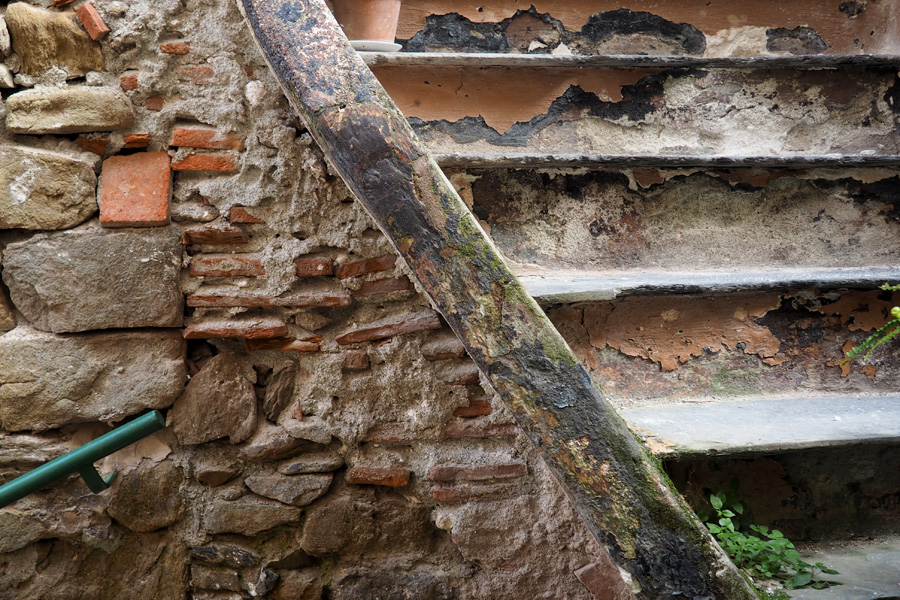
Details dating back to the 14th century
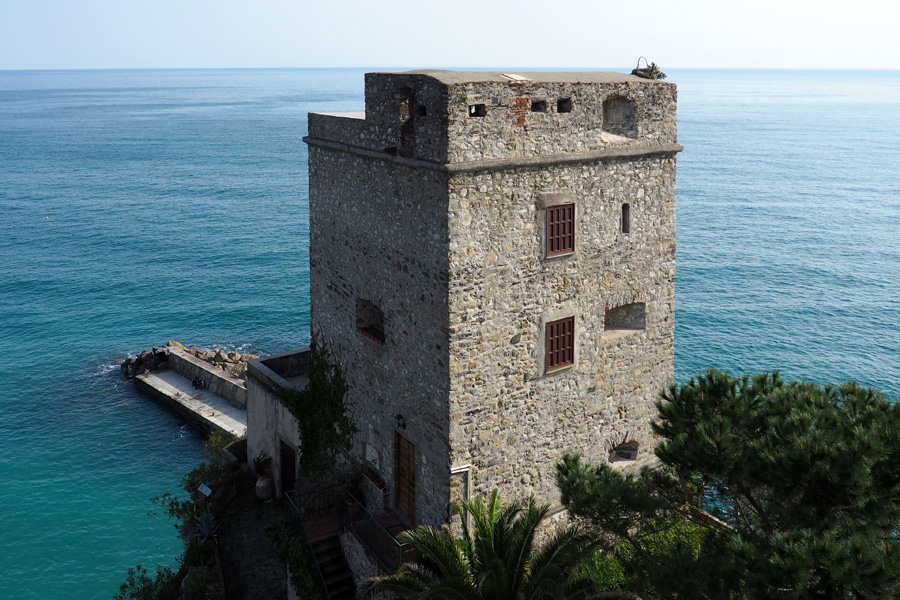
The Monterosso Castle – now a private residence

Piazza Garibaldi, Monterosso
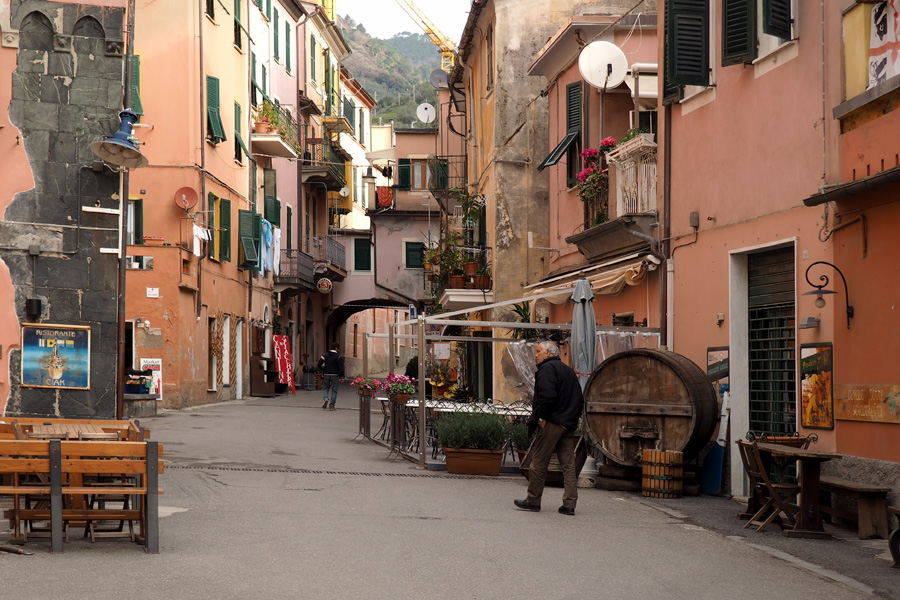
Piazza Colombo, Monterosso
After a restful night of sleep, hot showers and a breakfast of breads, cheeses, fruit and cappuccino, we set out early on our second day to hike as much of the coastal trail between the 5 towns of Cinque Terre as we could. The path between Monterosso and Vernazza was through lemon trees busting at the seams with ripe fruit, olive groves full of new buds but not a single olive, and a few terraced vineyards that had been cut back for the winter. Some of the larger and steeper farms had elevated monorails that made Nik’s head spin. He has dreamed about building a miniature train in his back yard, and every time we go on a hike or spend time in a large park, he mentions his dream. Now he has seen it in person, and has done the research to know that the Swiss-made pre manufactured version will cost approximately $125,000 for 300 meters. He also knows that we have some handy family members that are good with automotives that might be able to help design and build one!!!
The path itself was narrow and made with stones set into a mud bed and lined with meticulously built stone walls where the earth had to be cut back to make way for pedestrians. During the first couple hours, we only saw 3 or 4 other hikers which made us thankful that we decided to come during the off season.

On the path between Monterosso & Vernazza – freshly trimmed of overgrowth
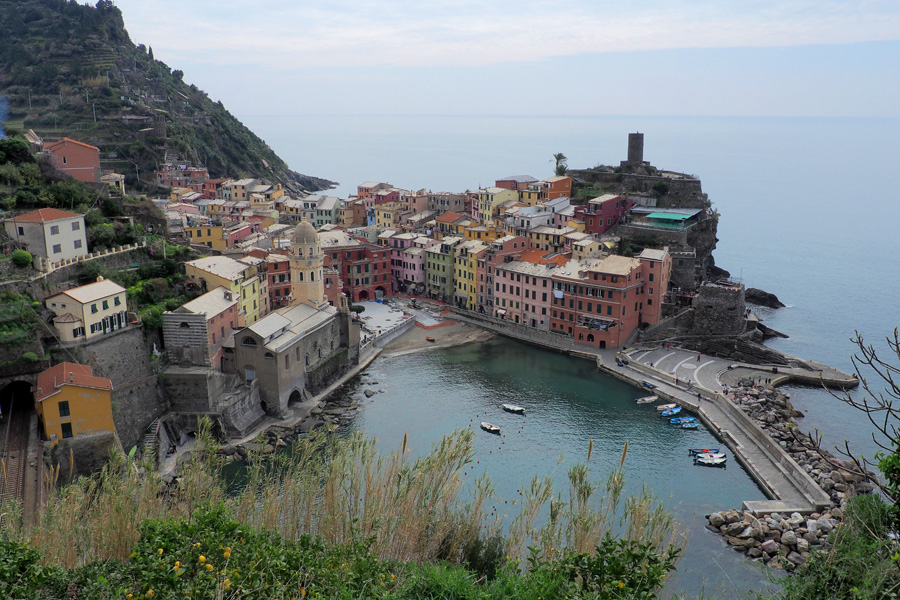
Vernazza and the sea

Nik’s dream locomotive
In Vernazza, we wandered through narrow streets and up and down ancient stone steps between buildings that had tilted and twisted over time. All of the town’s shutters were modern green metal contraptions, and most were closed. I am not sure if that is because most of the buildings are hotels that are only open during the summer and have been closed for winter, or if most people simply keep their shutters closed.
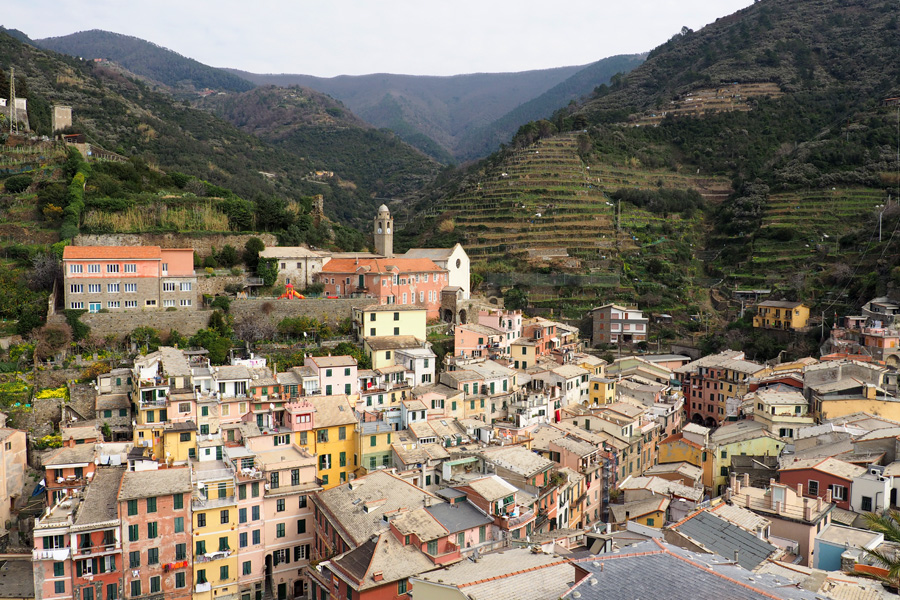
Vernazza looking towards the Apennine Mountains
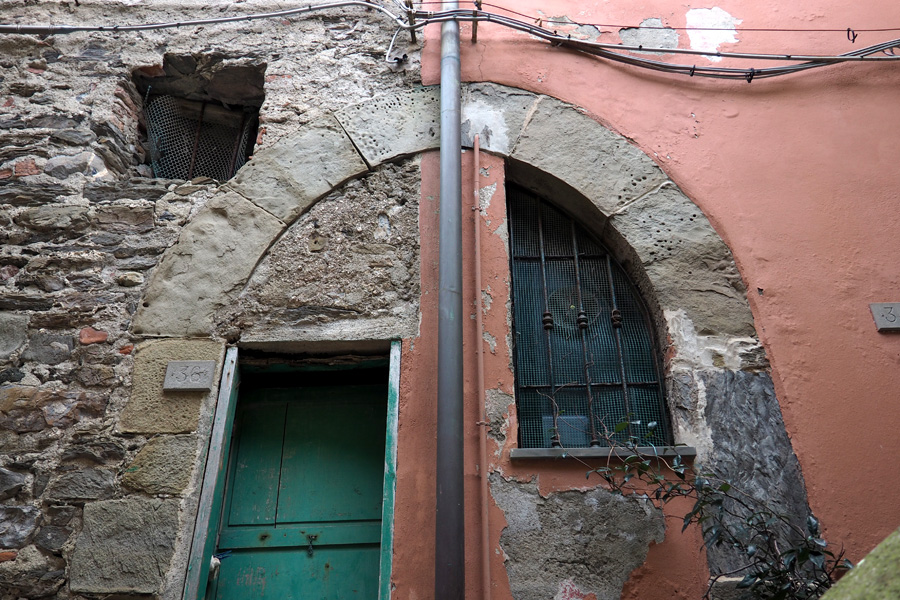
Infill, Vernazza
On the path between Vernazza towards Corniglia, we passed more and more hikers. Each time I did a quick evaluation of their clothing and their conversational style to decide if they should be greeted with the native “Buongiorno” or “Hello”. I used Italian most of the time so that our nationality was ambiguous, but occasionally it was nice to connect with fellow Americans with a familiar greeting.

Corniglia
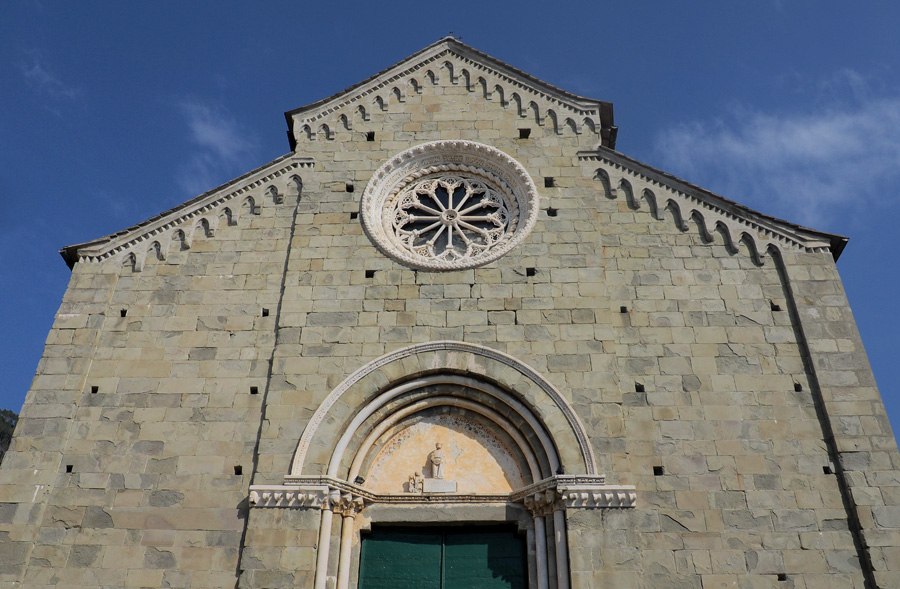
San Pietro Church, Corniglia
Corniglia was supposed to be our final stop for the day, but the day was still young and the weather incredible. We decided to take the train on to the fourth town, Manarola, because we could and because this was the town that Nik REALLY wanted to see. He claimed that it was the most photogenic and that if he was to have a dusk photo of any town, Manarola was the town he wanted.
We arrived at the Manarola train platform around 4:30pm to find the perfect viewpoint. First we went south along the base of the town and quickly realized that we could not see the city from there. We could see the sea, so we lingered for a while as clouds moved in and out. Next we went north and found our spot on an elevated walkway about 30 feet above the water where we could see the city open towards the Sea and nestle into the mountains. We sat there for well over an hour watching tourists take selfies with the town as their background.
The sun eventually set and Nik captured his perfect moment even though very few the town’s residents came home to open their shutters for him. As the sky turned black, we consulted my phone for dinner recommendations and settled on Nessun Dorma, a bar perched at the top of a hill opposite the town with the view above. We were one of three couples at the outdoor bar, and once again, we were thankful we had come during the off season. Our drinks, bruschetta and panini were perfect after a day walking by the sea.
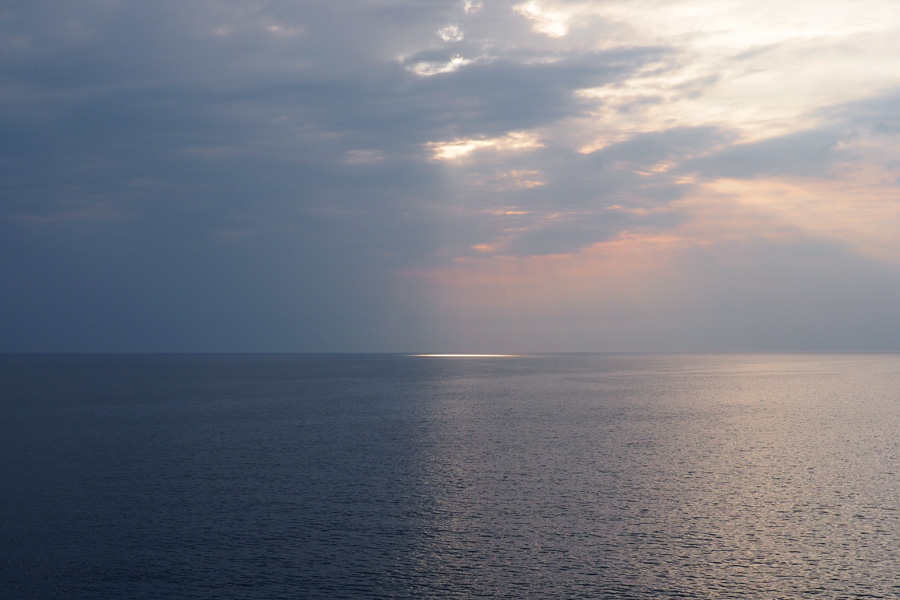
The Mediterranean
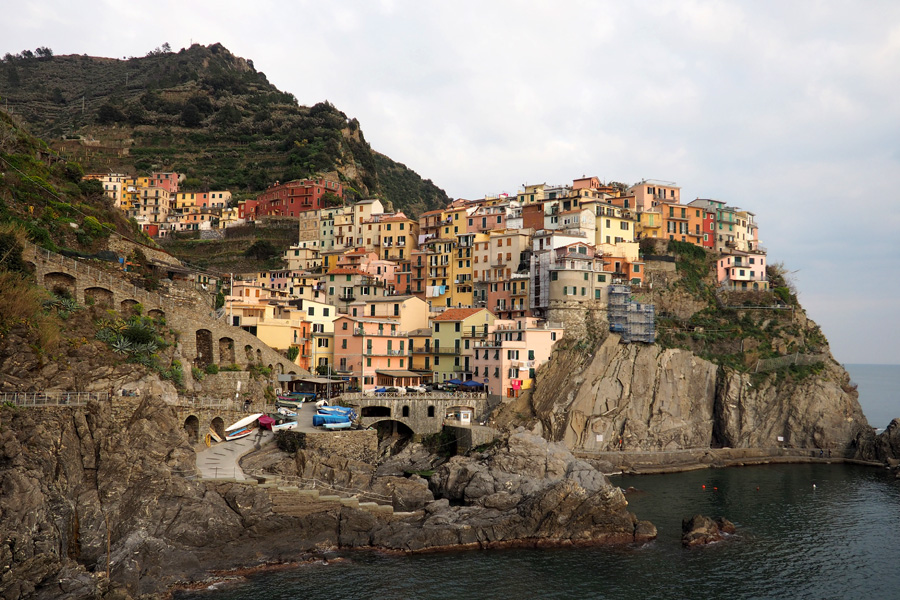
Manarola from the south
Our third day began with another great breakfast with Manuel (the guest house namesake) and a hike up to the cemetery at the top of the mountain between the new and old areas of Monterosso. The grounds were well maintained and the memorials dated back as far as the early 1900s with clergy members situated on the western edge facing the sea.
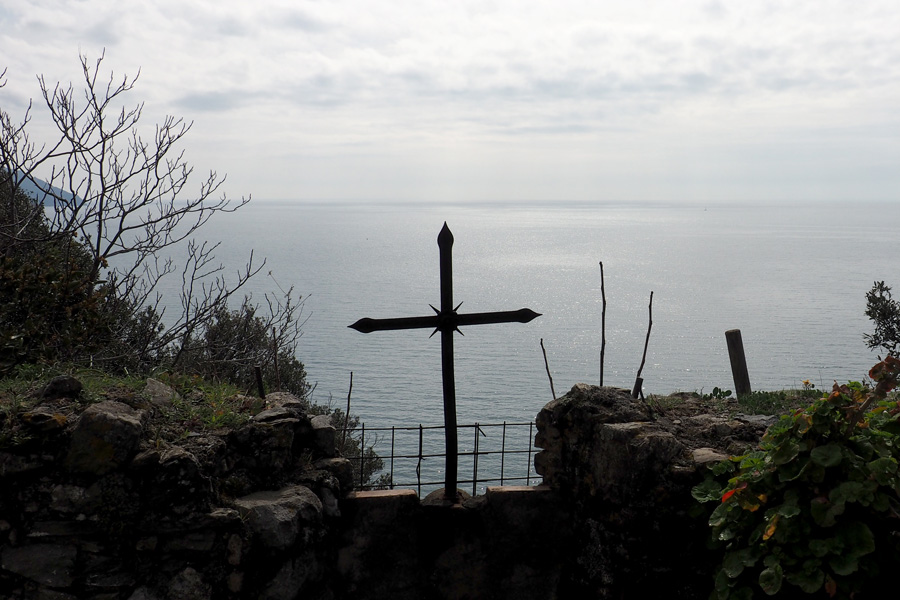
Monterosso Cemetery looking towards the Ligurian Sea
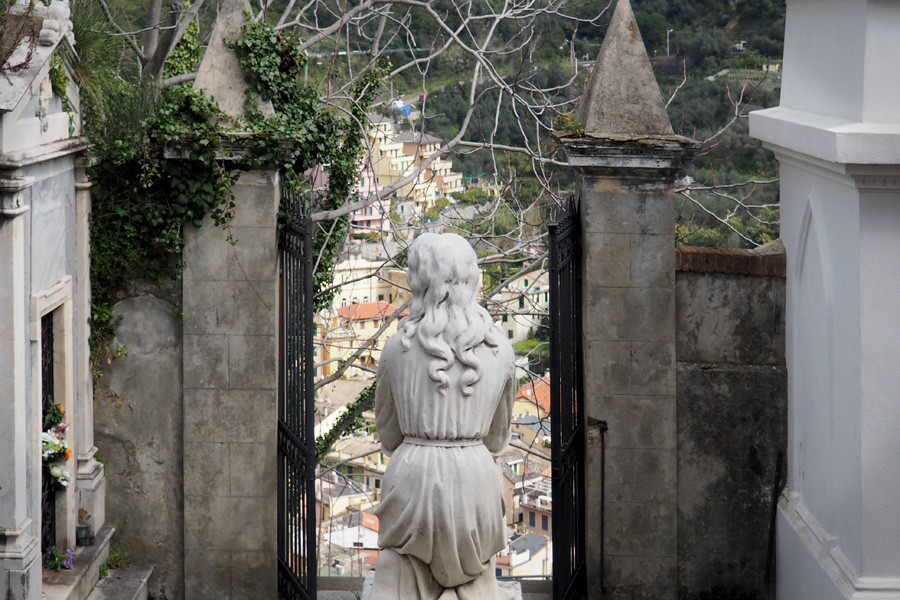
Memorial
After the local jaunt, we took the train to the fifth and final town of Riomaggiore. The literal translation of the town name is “Grand River” because a river once ran through the center of town with only bridges connecting the northern and southern slopes. Nik and I tried to imagine what it must have been like to have  water rushing beneath our paths, and wished we had seen the town then. But we were also grateful that the town had continued to prosper, so if covering the river was necessary for progress and stability, I understand it.
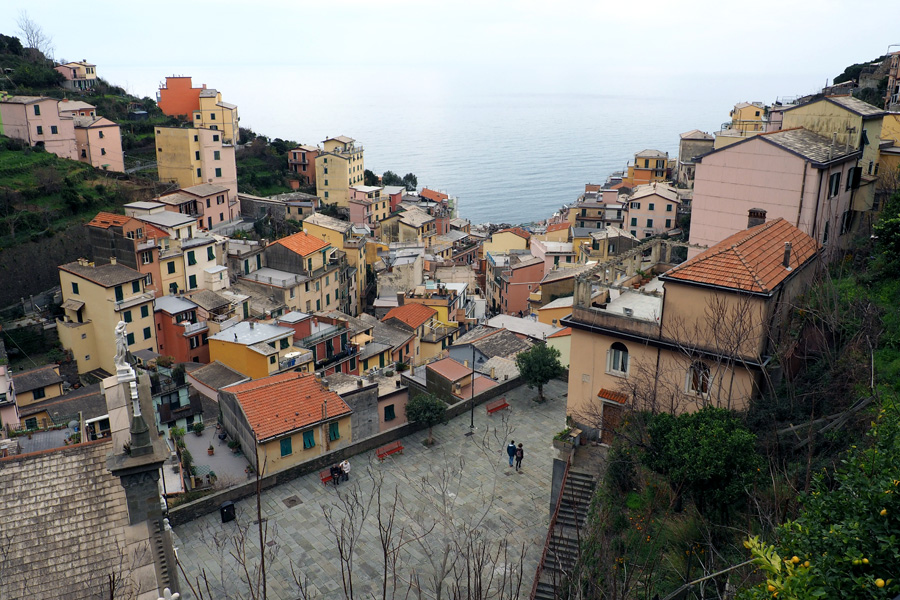
Riomaggiore, where the Great River once ran
We knew it would be raining for most of our fourth and final day, so when it was barely sprinkling after breakfast, we took advantage of the decent weather to go further uphill to the car road that services all five towns. It is positioned about half way up the side of the mountain and has hairpin turns every 1000 meters or so. As we walked on the shoulderless narrow road, Vespa Apes (pronounced app-ee), delivery trucks, Fiat hatchbacks and construction vehicles passed going both directions. It was not the most relaxing walk we have had here, but it’s always good to see how the locals get around! We ended the walk at the private club located at the northern edge of the public Monterosso beach. It was an unremarkable building with a small “marina” filled with small boats.
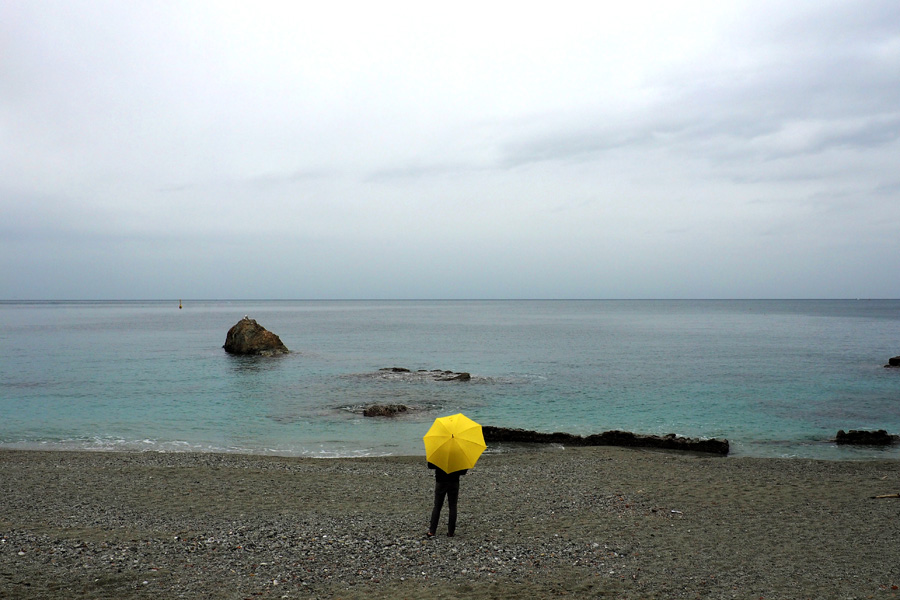
Rainy Day
On the way back we had lunch at Trattoria da Oscar which came highly recommended by our host. It is a 14 seat restaurant nicely designed with a well-lit arched stone ceiling and simply painted steel blue tables with pumpkin orange chairs. When we sat down, it was empty and the hostess (that I assume was an owner?) took our order of a caprese salad, marinated mussels and gnocchi with pesto. It was all amazing, especially the mussels.
The meal was followed by piccolo (small) gelati (pl. gelato), and then we confined ourselves to our room as it rained outside to edit photos and write our blog posts.

The Sinz/Daums*
*Photo taken by the daughter of a lemon-eating American on our first day in Cinque Terre and edited by Nik.
Nik’s Blog: Four Amazing Days in Cinque Terre, Italy
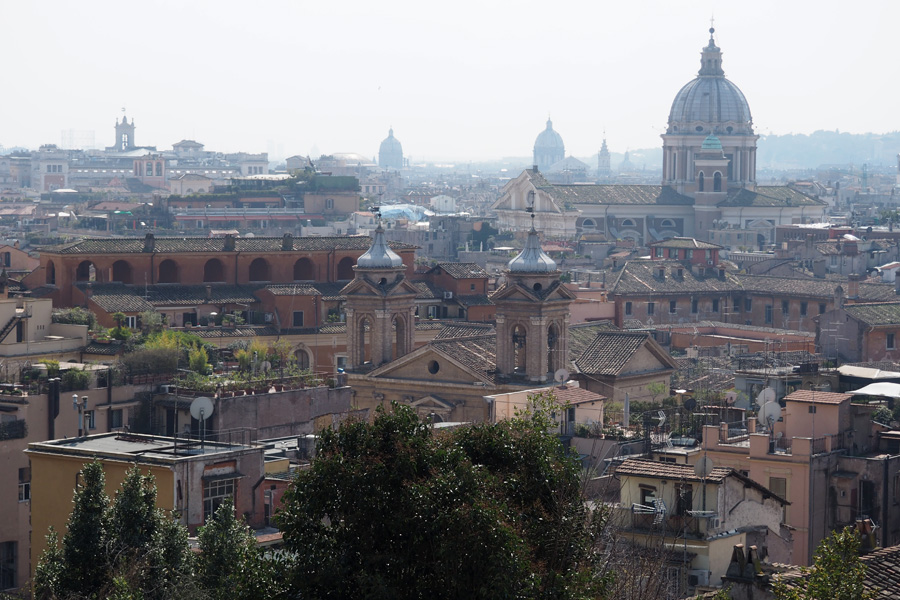
Rome, a birthplace of Western Civilization
Many people think that architects travel only to see buildings. They imagine that we drag our friends and families around the globe in search of every building by every notable architect that has ever lived just so that we can take the exact same photos of said buildings that we saw in our history books and monographs. This may be true of some architects, but not this one…most of the time. As I plan for a trip, if there is a building I know is important to the history of our civilization or to modern architecture, I definitely seek it out. Unfortunately, I am not the best student of ancient or modern architectural history or of current architecture. It is more likely that I will turn a corner and see something vaguely familiar only to find out two days later that it was designed by last year’s Pritzker Prize winning architect (currently the highest honor an architect can receive) or Michelangelo. Or I won’t turn a corner only to find out that I missed one of the masterpieces of our time. When this happens, I feel as though I am letting my profession down because I should have known better.
This happened two days ago…we had already walked 12 miles and were basically forced to go to the steps of the Vittorio Emmanuel Monument by the waves of tourists going in that direction. It was great to see up close because it is obviously a significant architectural monument that we had seen from a distance all week. Then when I was back at our apartment doing more research, I discovered that in our exhausted herding towards Vittorio, we completely missed one of the most important architectural and urban design sites of our time. Not 100 feet away is the Michelangelo designed piazza on Capitoline Hill, also known as Capidoglio. The piazza took centuries to finish, but the design has had an impact on nearly every city in the western world since the 1500s. I had been to the there in college, but I’m sad we missed it on this trip. Next time.
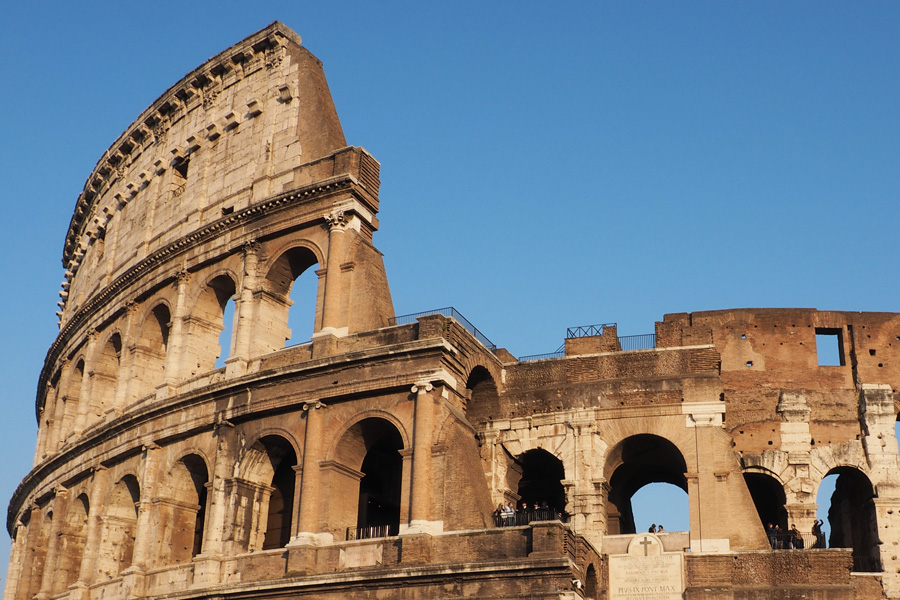
The Colosseum
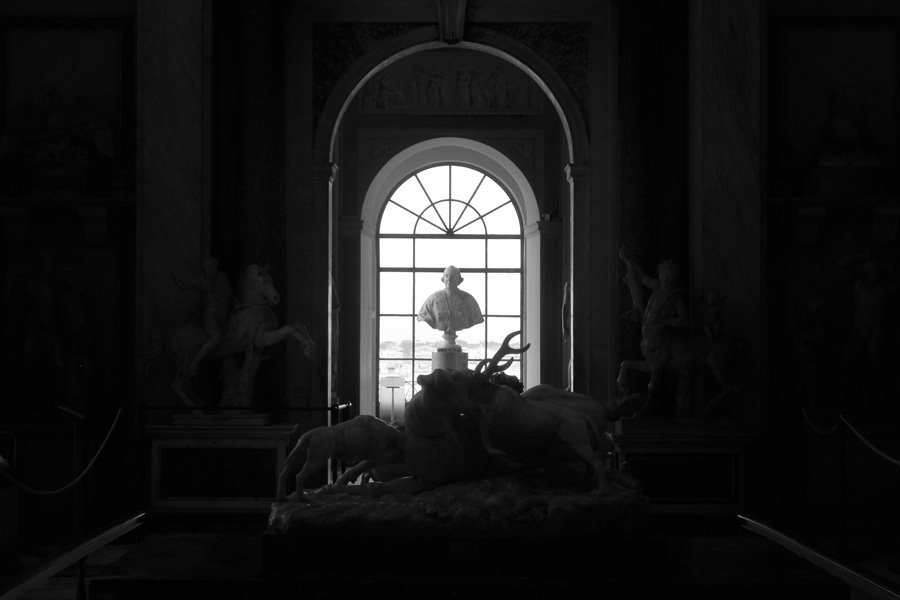
The Vatican Museum animal room
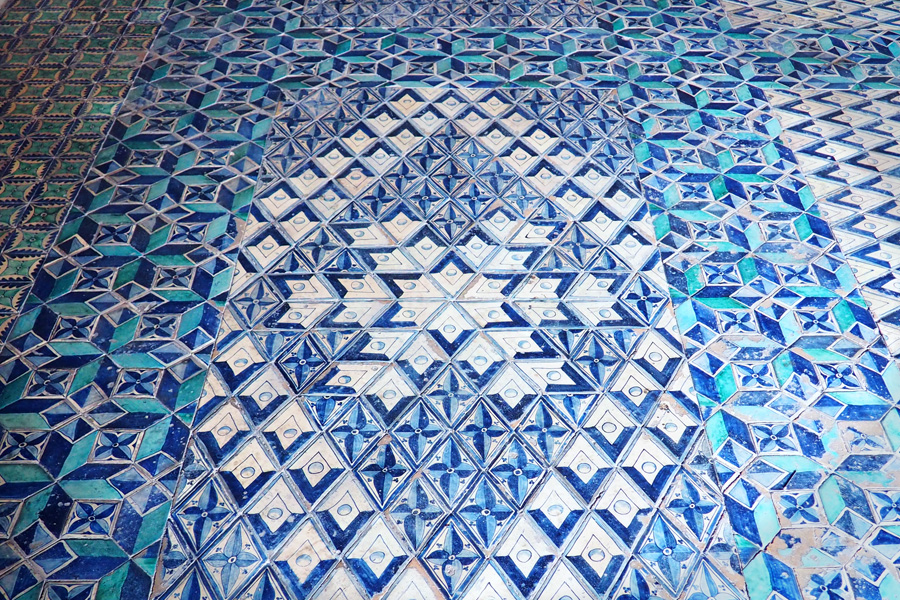
Painted floor tile at the Vatican Museum
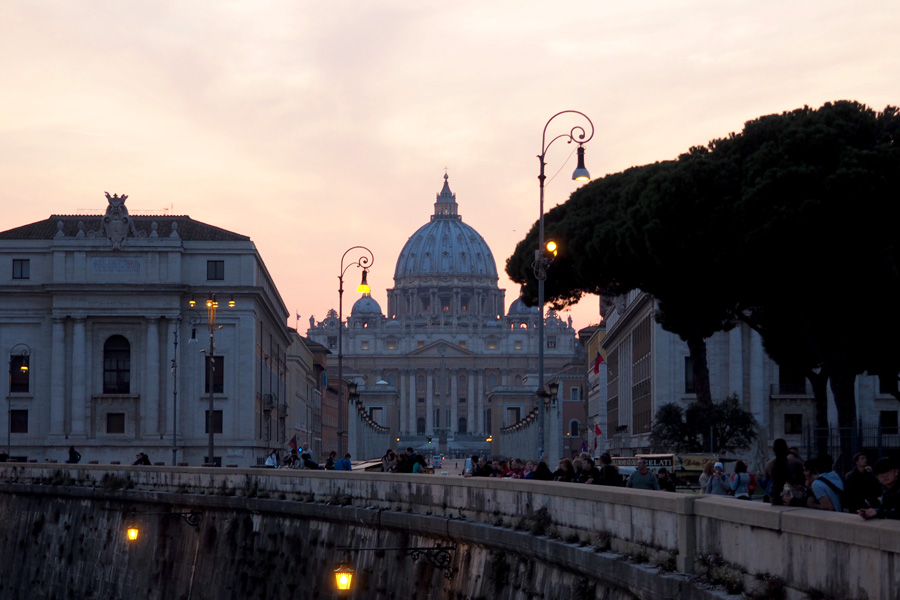
Saint Peter’s Basilica at dusk from Ponte Sant’Angelo
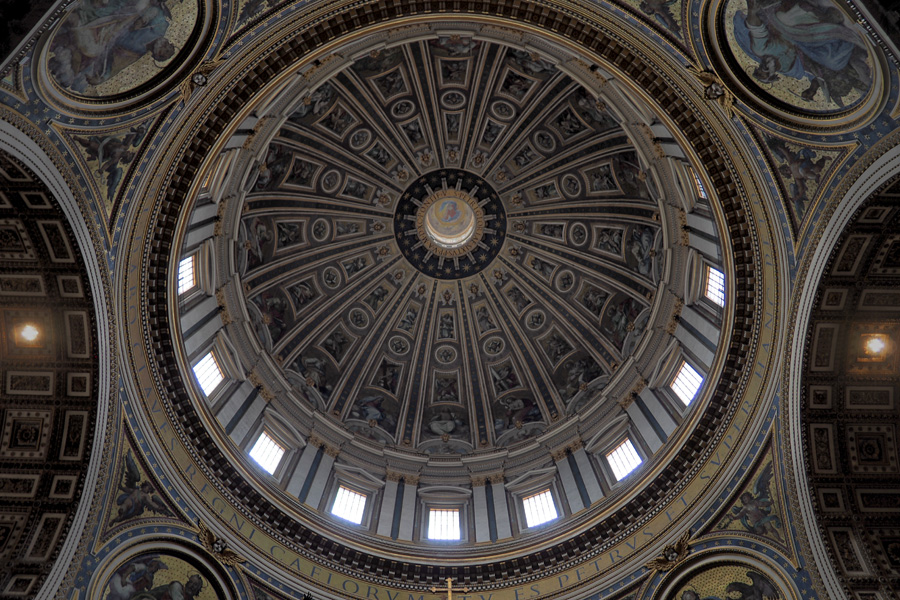
The main dome at Saint Peter’s Basilica
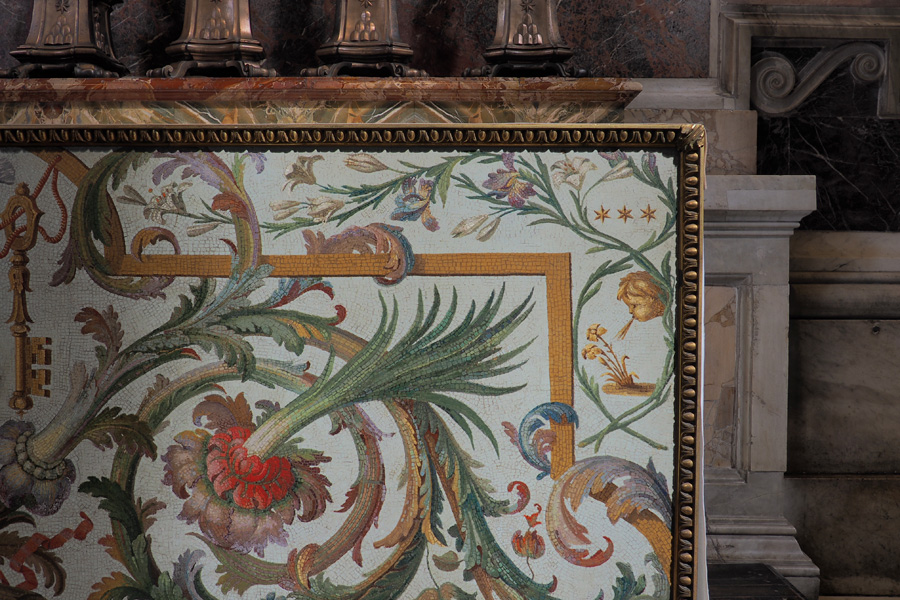
Altar mosaic at Saint Peters Basilica
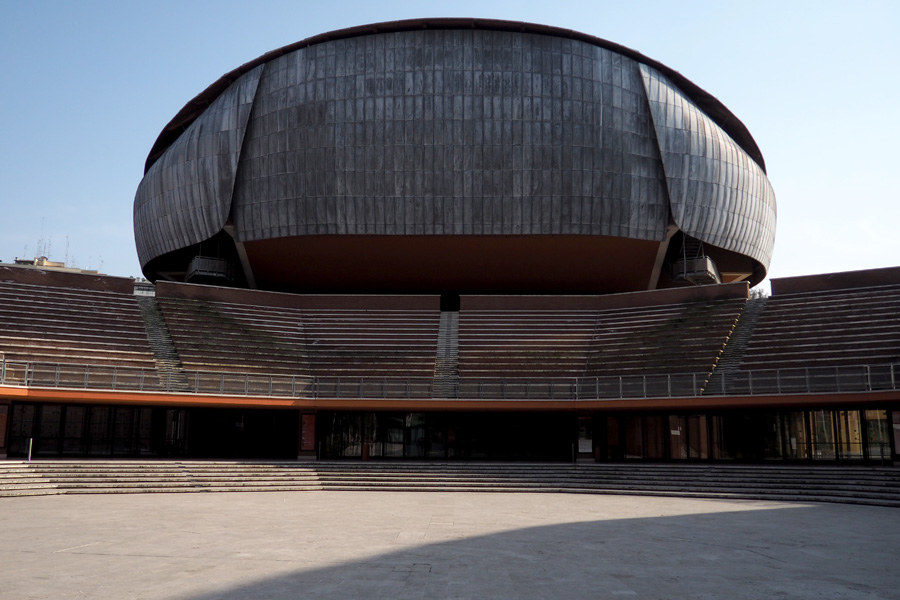
One of the Three venues at Auditorium Parco Del Musica by Renzo Piano
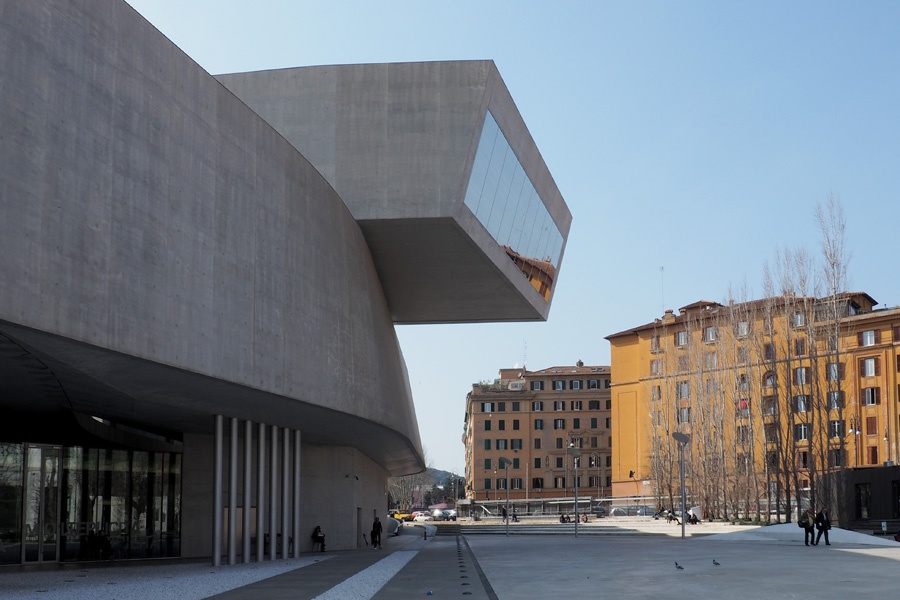
Old School & New School Meet – The MAXXI by Zaha Hadid
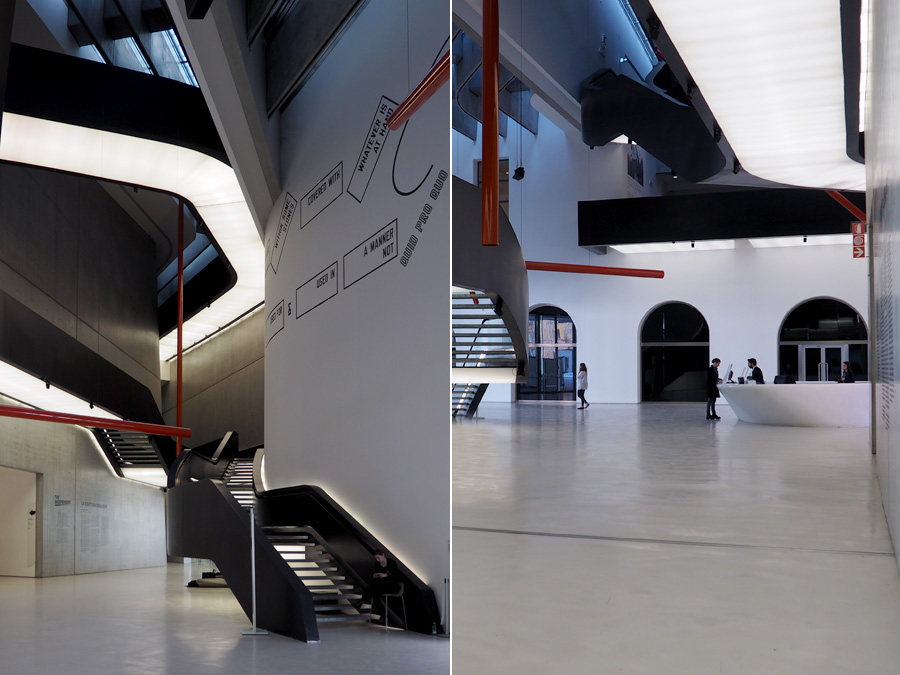
MAXXI Interior
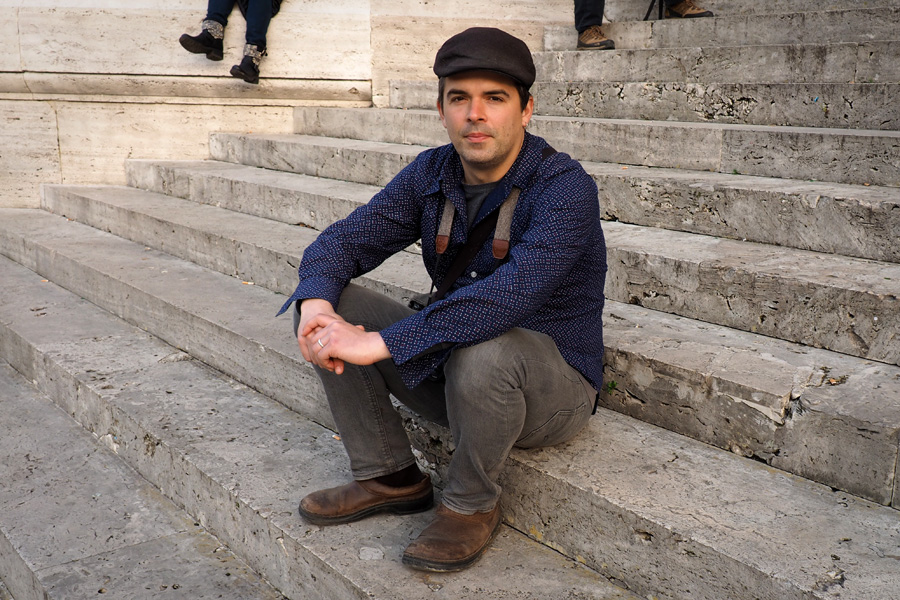
Nik on the steps in front of the Supreme Court building
Nik’s Blog: The Last Three Days in Rome






















































